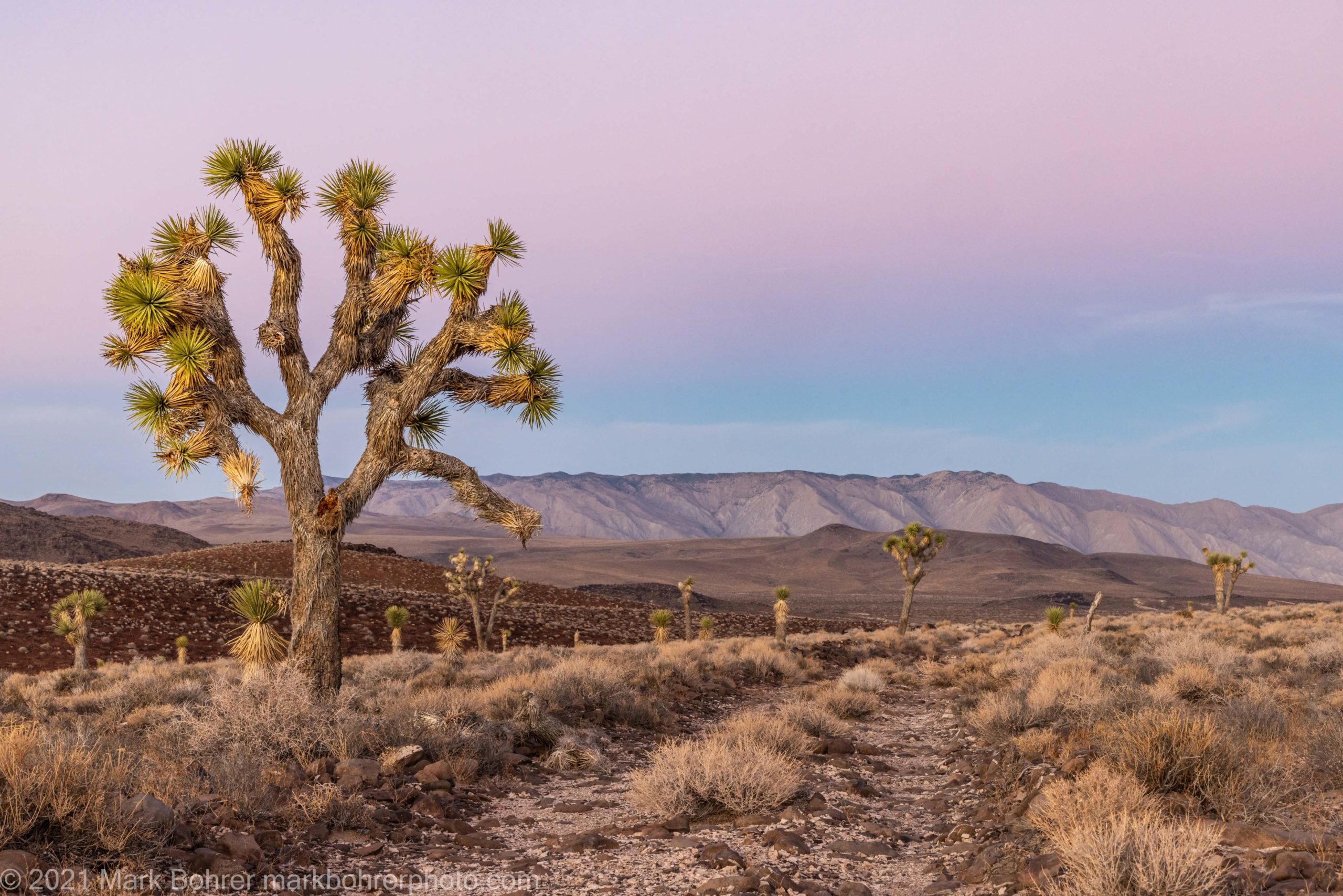|
The message came via WhatsApp. “Meet in the same spot at 12:30 to go out for sunset. We should be able to eat at the Panamint Restaurant. But bring some food just in case as we’ll be shooting stars after sunset.”
It was day three of Action Photo Tours’ workshop in Death Valley. We’d been up and out by 5am most days for sunrise shooting and out again at sunset at some of the park’s signature viewpoints. But tonight’s shooting was about Joshua trees, a rusted old car with bullet holes, and the Milky Way. Heading for Jets and Night Skies Action Photo Tours’ Kevin McNeal and Nicole Tino led us a short distance to the old car, in a plateau scattered with Joshua trees. With the desert’s limited water, plants adopt a uniform distribution with the big ones widely separated. More or less distant mountains rose in all directions, with a canyon dropoff to the east. The sky was almost painfully blue and clear ahead of sunset.
Planning for Joshua Trees – Shooting The Old Car After a friend’s tentative ID later (thanks Tad), I confirmed the car was a 1941 Buick Super. The groups of exhaust accents should have been a giveaway – modern Buicks still have them.
Around 3 o’clock there was a roar as an F-22 whipped around the mountains. A couple people went back to Rainbow Canyon with Nicole to try for some pictures, but the jets were just too fast.
Towards sunset, most of us were at the old Buick. I made some final shots of the car with the sun diffracting across the trunk, and Joshua trees in pink post-sunset light. Backpacks and most photo gear were left at the site. Then we all walked back to the cars to wait for full dark.
By headlamp light around 8 o’clock, we made our careful way back out to the Buick. Kevin and Nicole carried LED lights to ‘paint’ the old car. All of us mounted cameras to tripods with our night photography lenses. For me this was a reasonably lightweight Rokinon 14mm f/2.8 AE manual focus lens. If I’d planned better I’d have brought a sharper but much heavier Sigma 14mm f/1.8 Art lens I’ve used before for night sky shots. But I wasn’t sure how much I’d have to carry without a break, so I left the Sigma lens home.
Shooting At Night Kevin showed us the Gap method for focusing – he stood by the car, well lit by LED light with his Gap sweatshirt on, and we adjusted focus until the Gap logo was sharp. Then he and Nicole added lighting to the Buick. I relied on depth of field for the Milky Way to be sharp, but I should have manually bracketed focus for sharpness in separate shots of car and night sky. Star sharpness from depth of field with my 14mm lens isn’t bad. But I would have benefited from shots put together with focus stacking. We’d been using 2 second-delayed shutter triggering for pictures throughout the workshop. I had a wireless remote for my camera, another good way to prevent camera vibration on a tripod when triggering the shutter. I didn’t trust the sharpness of the Rokinon 14mm at f/2.8, so I stopped down slightly to f/3.2. This also gave me slightly more depth of field. And a mirrorless EOS R5 camera eliminated the vibrating mirror slap of a dSLR. The 400 Rule and Longest Exposure Times
I wanted to convey a sense of abandonment and isolation in this picture. A city’s bright lights and hurry mostly leave Death Valley alone.
Towards the end of the session I decided to shoot a few horizontal pictures with slightly different light and a shortened Milky Way. I also captured the glow of distant Las Vegas on the southeastern horizon. You still can’t escape city lights, even in remote Death Valley.
Shot Notes I should have done a few things differently – used different ISOs, used a sharper lens, increased exposure, moved around more for different viewpoints. Especially when you’re part of a group, it can be tough to move and remember to do everything you want. It’s also challenging to use a headlamp to adjust tripod height and see where you’re moving when everyone else doesn’t want stray light in their pictures. Night photography is usually better as a solo or at most 2-person activity, once you’ve learned how from books, online research and a good live instructor or two. Acknowledgements More Information – Keimig, Lance (2016), Night Photography: Finding Your Way In The Dark (2nd edition). Focal Press. – Shaw, Mike (2017), The Complete Guide to Landscape Astrophotography – Understanding, Planning, Creating, and Processing Nightscape Images. Routledge – Taylor and Francis Group. – Wu, Jennifer and Martin, James (2014), Photography NIGHT SKY A Field Guide for Shooting After Dark. Mountaineers Books. – Action Photo Tours (Nov 28- Dec 2, 2021), Death Valley Photo Workshop. Retrieved from https://actionphototours.com/workshops/death-valley-photo-workshop-2/ – PhotoPills (nd), Shoot Legendary Photos. Retrieved from https://www.photopills.com. |
(408) 483-3782
Curious about how to shoot ruins?(408) 483-3782












Recent Comments